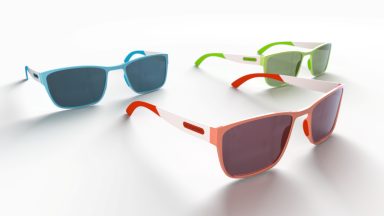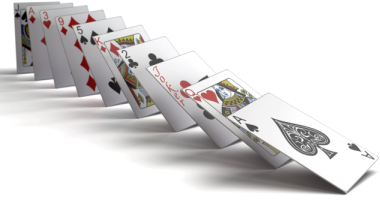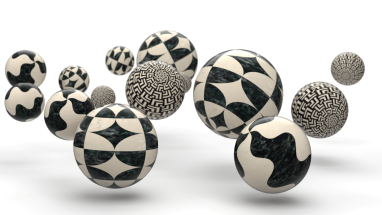You can edit general properties such as the selected object's name,
opacity, and show/hide
state.
| Name |
Shows the name of the selected
object. Type over the name to change
it.
|
| Opacity |
Controls the degree to which
light can pass through an object. If the value is set to 100, the
object is completely opaque. Lower the value to increase
transparency. |
| Visible |
Select to show the selected object
in the 3D Viewport. Clear to hide the object in the 3D
Viewport. Emissive shaders do
not emit light into a scene when their parts are
hidden.
|
| Disabled |
Hides the selected model or part.
Lighting is not affected. The object goes in a
dormant state in the scene; you can only re-enable it by
clearing Disabled.
|
| Faded |
Hides a model from the camera's
view, but leaves it in the scene for lighting. |
| Original
Source |
Lets you relocate and reimport
the CAD model if it is in a different location than when you
initially imported the model. Select Monitor File to automatically reimport the file
when sources change. |
| Shadow Catcher
(Accurate Mode Only) |
Turns any part object geometry
into a shadow catcher object. Shadow catchers show the background
through them and display shadows cast from lighting in the scene. For example, you can create a wall and specify
it as a shadow catcher.
|
Formation
The Formation settings apply when you pattern a model.
| Formation |
Specifies
the model to pattern. The selected model is hidden in the 3D
Viewport. You can drag different models into
the pattern to form a customized pattern. In this case,
Formation is not
available.
|
| Type |
Specifies the pattern type:
Vee, Circle, Grid, Scatter. |
Vee

Vee formations use an angle to specify
the opening angle of the vee.
| Number
of Objects |
Specifies the number of objects in
the pattern. |
| Angle |
Specifies the opening angle of the
vee. |
| Distance XYZ |
Specifies a vector whose length
defines the distance between instances and whose direction affects
the pattern orientation. |
| Rotation XYZ |
Specifies the rotation of the
instances in the pattern in Euler angles (degrees). |
| Scale
XYZ |
Specifies the scale of the
instances in the pattern in X,Y, and Z dimensions. |
| Relative |
Accumulates the distance,
rotation, or scale over the sequence of instances. When cleared, the
distance, rotation, or scale is absolute (constant). |
| Scale
All |
Specifies an overall scale multiplier to the X, Y,
and Z dimensions of the scale for all instances. |
Circle

You can use the Circle formation to arrange instances in a circle or
arc. The Circle is the only formation where
several parameters are linked such that changing one affects the others. For
example, if you increase the Number of
Objects, the Distance XYZ
value decreases so the Radius stays the
same.
| Number
of Objects |
Specifies the number of objects in
the pattern. |
| Radius |
Specifies the radius of the
circular pattern. |
| Angle |
Specifies a circle or an arc by
specifying a value less than 360°. |
| Distance XYZ |
Specifies a vector whose length
defines the distance between instances and whose direction affects
the pattern orientation. |
| Rotation XYZ |
Specifies the rotation of the
instances in the pattern in Euler angles (degrees). |
| Scale
XYZ |
Specifies the scale of the
instances in the pattern in X,Y, and Z dimensions. |
| Relative |
Accumulates the rotation or scale
over the sequence of instances. When cleared, the rotation or scale
is absolute (constant). |
| Scale
All |
Specifies an overall scale multiplier to the X, Y,
and Z dimensions of the scale for all instances. |
Grid

Depending on the value of Number of Objects
X, Y,
and Z, the Grid formation can be a line (a value greater than 1 in a single
dimension and a value of 1 in the other two dimensions), a plane (a value greater
than 1 in two dimensions and a value of 1 in the third dimension), or a cube (a
value greater than one in all three dimensions). The total number of instances is
equal to the product of the Number of Objects
X, Y, and Z.
The total number of objects
is the product of the values of Number of Objects
X, Number of Objects Y, and
Number of Objects Z.
| Number
of Objects X |
Specifies the number of objects in the X
dimension. |
| Number
of Objects Y |
Specifies the number of objects
in the Y dimension. |
| Number
of Objects Z |
Specifies the number of objects in
the Z dimension. |
| Distance XYZ |
Specifies a vector whose length
defines the distance between instances and whose direction affects
the pattern orientation. |
| Rotation XYZ |
Specifies the rotation of the instances in the
pattern in Euler angles (degrees). |
| Scale
XYZ |
Specifies the scale of the
instances in the pattern in X,Y, and Z dimensions. |
| Relative |
Accumulates the distance,
rotation, or scale over the sequence of instances. When cleared, the
distance, rotation, or scale is absolute (constant). |
| Scale
All |
Specifies an overall scale multiplier to the X, Y,
and Z dimensions of the scale for all instances. |
Scatter

The Scatter formation allows completely random arrangements of objects
within a specific range. Equal values for Minimum and Maximum create
a deterministic transformation value for that degree of freedom.
| Number of Objects |
Specifies the number of objects
in the pattern. |
| Position Range XYZ |
Specifies the Minimum and Maximum limits for the random
computation of translations (position) of each instance. |
| Rotation Range XYZ |
Specifies the Minimum and Maximum limits for the Euler angles
X, Y, Z for the random computation of the rotations of each
instance. |
| Scale
Range XYZ |
Specifies the Minimum and Maximum limits for the random
computation of scale of each instance. Uniform specifies a random
scale in the X, Y, and Z dimension.
|
| Scale
All |
Specifies an overall scale multiplier to the X, Y,
and Z dimensions of the minimum and maximum scales for all
instances. |